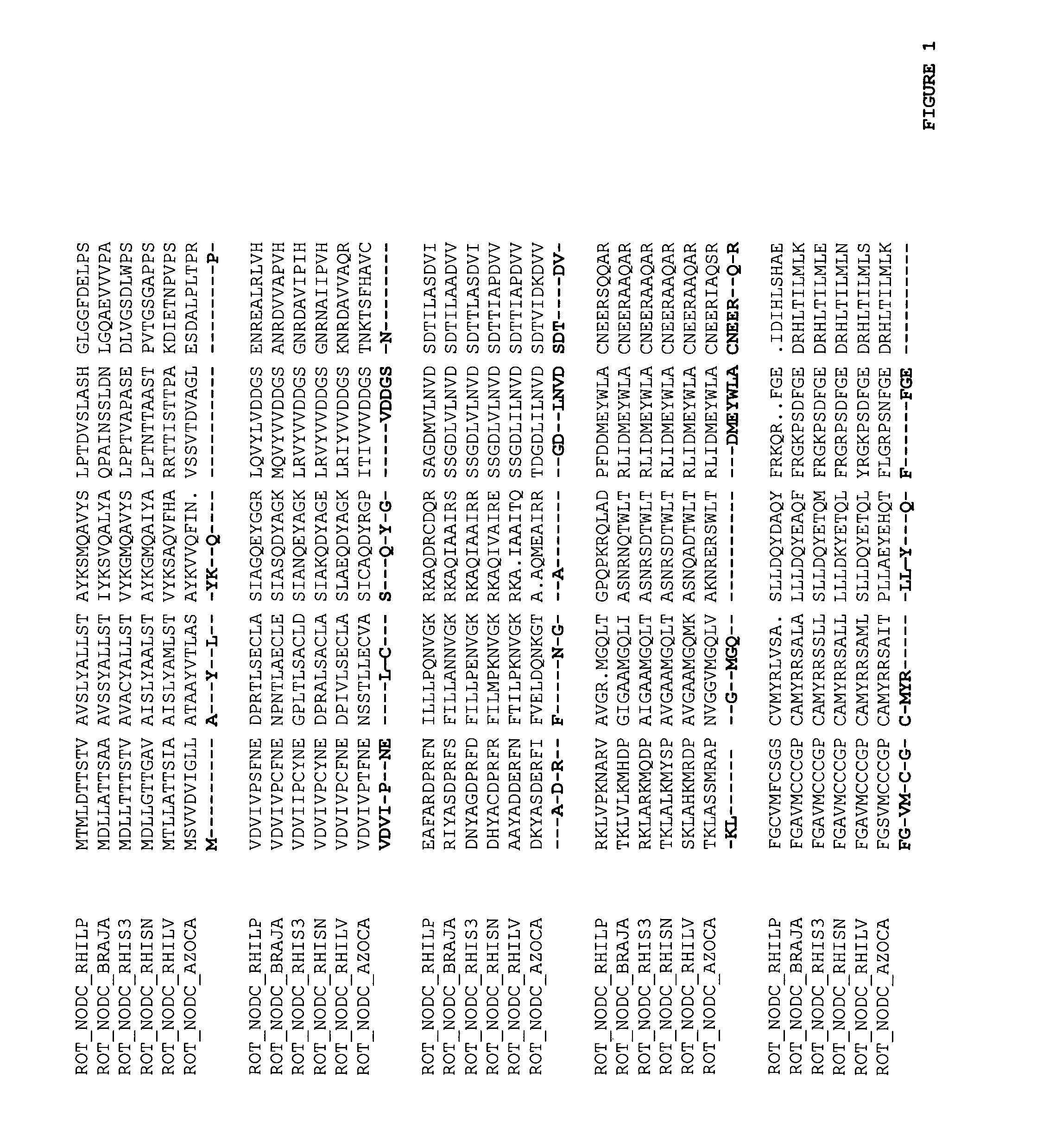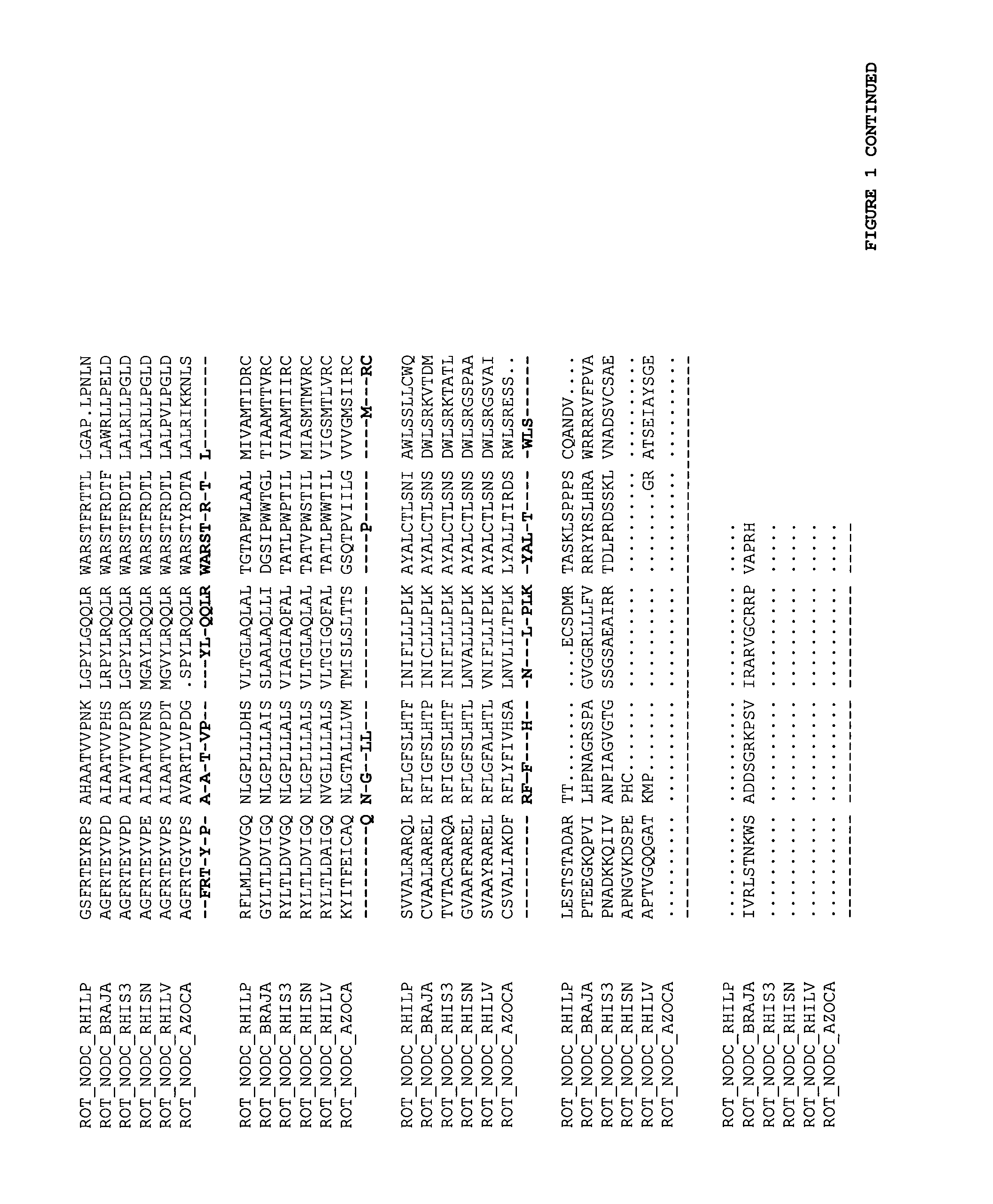Methods for altering the reactivity of plant cell walls
a plant cell wall and reactivity technology, applied in the field of methods for altering the reactivity of plant cell walls, can solve the problems of not possessing the chemical versatility of synthetic fibers, not having the chemical versatility of natural cellulose containing fibers, and not able to withstand well washing, so as to increase the amount of positively charged oligosaccharides and improve the reactivity
- Summary
- Abstract
- Description
- Claims
- Application Information
AI Technical Summary
Benefits of technology
Problems solved by technology
Method used
Image
Examples
example 1
Construction of Chimeric Plant-Expressible Genes Encoding a N-Acetylglucosamine Transferase Protein Fused to a Golgi Signal Anchor Sequence
[0116]Using standard recombinant DNA techniques, a plant expressible NODC chimeric gene was constructed containing the following operably linked DNA fragments:[0117]a 35S promoter region from CaMV[0118]a DNA fragment coding for an untranslated leader sequence (5′Cab22L)[0119]a DNA fragment coding for the 35 N-terminal amino acids of β-1,2-xylosyltransferase from Arabidopsis thaliana [0120]a DNA fragment coding for NODC of Azorhizobium caulinodans cloned in frame with the previous DNA fragment[0121]a transcription termination and polyadenylation signal from the 35S transcript of CaMV (3′ 35S)
[0122]The chimeric gene was introduced between T-DNA borders of a T-DNA vector together with a chimeric bar gene providing resistance to phosphinotricin. The resulting T-DNA vector was named pTJN 6. The sequence of the T-DNA of this vector is provided in SEQ ...
example 2
Analysis of Root Length of Transgenic Arabidopsis Plants
[0124]Wild-type Arabidopsis and transgenic Arabidopsis plants transformed with pTJN6 (NODC with heterologous Golgi signal anchor sequence) and pTGK42 (NODC without heterologous Golgi signal anchor sequence; see WO2006 / 136351) were gas sterilized and plated on 0.5× Murashige and Skoog (MS) basal salt medium including modified vitamins (Sigma) and 20 g / l glucose. After imbibing for 2 days at 4° C., plates were placed vertically in a growth chamber with a day / night regime of 16 h of light at 21° C. for a period of 9 days. Plates were scanned on a bench-top scanner and measurements were done in ImageJ. Data were exported to Microsoft Excel for analysis. The root length was measured and compared to that of wild-type plants. FIG. 3A shows that, whereas the root length of plants transformed with pTGK42 is about 25% shorter than that of wild-type, there is no significant difference in root length between wild-type and transgenic plants...
example 3
Characterization of GlcNAc Oligomers in Cell Walls of Transgenic Arabidopsis Plants
[0125]The GlcNAc oligomers in transgenic Arabidopsis plants transformed with pTJN6 were analyzed using a combination of derivatization, high-performance liquid chromatography and mass spectrometry as described in Rozaklis et al. (2002, Clinical Chemistry 48:131-139). Briefly, leaf samples (20-150 mg) were snap frozen in liquid nitrogen and grinded in 2 ml eppendorf tubes using a rich mill grinder. 0.5 ml 80% MeOH was added and the tubes were vortexed and centrifuged in a precooled table top centrifuge (5 min 14000 rpm). Supernatant was transferred to a fresh 2 ml tube and freeze dried in a speed vac. The pellet was resuspended in 100 μl MeOH containing 0.5M PMP and 100 μl 800 mM NH3. The reaction mixture was incubated at 70° C. in a thermomixer (Eppendorf) for 9 min at 850 rpm. After this incubation step, the reaction mixture was neutralized by adding 200 μl 800 mM formic acid and further made up to 5...
PUM
| Property | Measurement | Unit |
|---|---|---|
| Electric charge | aaaaa | aaaaa |
| Electric charge | aaaaa | aaaaa |
| Mass | aaaaa | aaaaa |
Abstract
Description
Claims
Application Information
 Login to view more
Login to view more - R&D Engineer
- R&D Manager
- IP Professional
- Industry Leading Data Capabilities
- Powerful AI technology
- Patent DNA Extraction
Browse by: Latest US Patents, China's latest patents, Technical Efficacy Thesaurus, Application Domain, Technology Topic.
© 2024 PatSnap. All rights reserved.Legal|Privacy policy|Modern Slavery Act Transparency Statement|Sitemap



